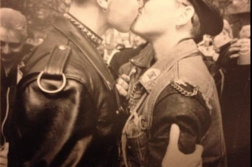 LESBIAN DEATH
LESBIAN DEATH
Desire and Danger between Feminist and Queer
by Mairead Sullivan
U. of Minnesota Press. 161 pages, $26.
THE TITLE Lesbian Death is both misleading and off-putting. And unfortunate, because rather than being a book about lesbians losing their lives, it’s an examination of the relevance of the term “lesbian” at the present moment. More specifically, it addresses the current fear among some lesbians that, with the evolution of identities such as “queer,” “trans,” and the ever-expanding iterations of lgbtqia+ labels, “lesbian” is either being erased or becoming obsolete.
A chapter titled “Lesbians Killed the Lesbian Bar,” for example—which focuses not only on the bars but also on the Michigan Womyn’s Music Festival—considers the fate of the lesbian in the age of Queer Studies. Sullivan argues that several developments were to blame for the demise of the lesbian bar. The invasion of technology and other industries into cities like San Francisco forced patrons to move away. Rising rents on commercial spaces caused the bar owners to be priced out. Lesbian life was becoming mainstream through the media (think Ellen DeGeneres and 1990s “lesbian chic”) and legal progress such as marriage equality. There was a loss of political commitment to anti-capitalism among activists, and lesbian identity itself went through growing pains.
Sullivan stresses throughout the book that one of the failures of lesbian activism was an inability to move beyond a white framework and genuinely build coalitions with communities of color. Today, lesbian bars have adapted and do exist, albeit in much smaller numbers. They are more inclusive, frequented by a mixed clientele that is aware of the bars’ status as safe space and chooses them for that reason.
Another illuminating chapter takes on “lesbian bed death.” In the 1980s, studies showed that as domesticity among lesbian couples rose, sex plummeted. Activists mobilized and asserted that sex should be a part of community-building—for instance through group discussions of sexual practices. At the same time, the feminist sex wars were raging between anti-pornography militants and pro-sex radicals. The author argues that because of the sex wars, by the 2000s feminism was viewed by the public as reductive, moralizing, and punitive, and this is why queer theorists distanced themselves from feminism and, by implication, lesbians. The term “queer” offered multiple forms of sexuality for a variety of genders, whereas they understood feminist politics as offering only the dangers of sex and none of the pleasures.
The specter of TERFs (Trans-Exclusionary Radical Feminists) as they emerged in the 1990s and the 2000s is raised. According to Sullivan, the Michigan Womyn’s Music Festival ultimately shut down because of the organizers’ insistence that the festival remain a space for the “shared experience of girlhood socialization” and the “specificity of female experience.” More recently, trans lesbians’ demands to be included in lesbian spaces have been interpreted by some as an infuriating incursion.
In the end, Sullivan demonstrates that lesbian anxiety stems from multiple sources. For some, the use of “queer” as an expanded definition of sexuality and gender possibilities is threatening to lesbian identity as such. For others, resentment of trans women’s incursion into lesbian space is a sticking point. There are lesbians who mourn the loss of a radical political cause and the success of the assimilationist agenda that spearheaded the struggle for same-sex marriage. And there are those who simply miss the joy that discovering lesbianism offered them.
In response, Sullivan reveals a broader story. While various causes and groups have fallen away, many have adapted. Dyke Marches, which began in the 1990s with the Lesbian Avengers, continue to thrive at Gay Pride Weekends. Olivia Cruises (once Olivia Records) and the Dinah Shore Weekend in Palm Springs both attract all kinds of self-described lesbians, even though few might name themselves feminists. Sullivan also discusses the recent popularity of “lesbian ephemera” such as “The Future Is Female” T-shirts and other consumer products. The rise of social media has allowed mass marketing of lesbian symbols and slogans, many of which were invented years ago but present themselves as the latest fashion.
No two people can have exactly the same experience. The labels that we use to describe ourselves might mean different things to different people. In looking at the contested meanings of “lesbian” through the last half century, it helps to keep in mind that no one group can speak for everyone. The arguments among lesbians have been simmering ever since “lesbian” came into general use. The simple fact of this book’s existence proves that the lesbian—however defined—is far from dead.
Martha K. Davis is the author of the novel Scissors, Paper, Stone.



